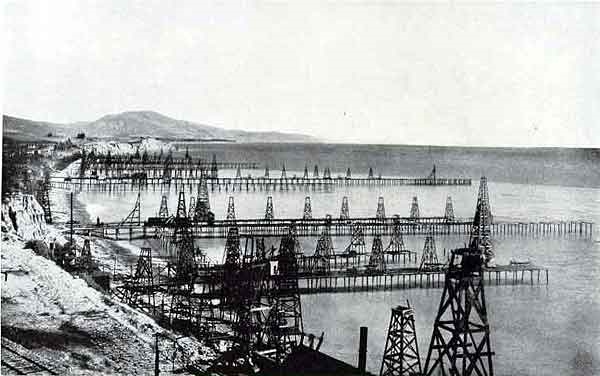by Bruce Wells | Nov 8, 2025 | Offshore History
The U.S. offshore drilling for oil began in the late-19th century on lakes and at the ends of Pacific Ocean piers. Until an innovative Kerr-McGee drilling platform in 1947, no offshore drilling company had ever risked drilling beyond the sight of land.

Many of the earliest offshore oil wells were drilled from piers at Summerland in Santa Barbara County, California. Circa 1901 photo by G.H. Eldridge courtesy National Oceanic & Atmospheric Administration.
In 1896, as enterprising businessmen pursued California’s prolific Summerland oilfield all the way to the beach, the lure of offshore production enticed Henry L. Williams and his associates to build a pier 300 feet out into the Pacific — and mount a standard cable-tool rig on it. (more…)
by Bruce Wells | Oct 1, 2025 | Petroleum Technology
Offshore oil and natural gas platforms have proven useful after retirement. Hundreds of former platforms serve as aquatic habitats. A jack-up rig in Galveston, Texas, is an offshore museum. There’s a historic mobile rig in Morgan City, Louisiana, that in 2024 was added to the National Register of Historic Places. Another mobile platform launched satellites from 1999 to 2014. (more…)
by Bruce Wells | Jul 27, 2025 | Offshore History, Petroleum in War
Routine seabed scan for new pipeline revealed Nazi sub less than one mile from its last victim.
During World War II, U-boats prowled the Gulf of Mexico to disrupt the flow of oil carried by tankers departing ports in Louisiana and Texas. Sixty years later, seabed surveys found U-166 — and its last victim.
Petroleum exploration and production companies operating in the U.S. outer continental shelf (OCS) typically provide government scientists with sonar data for areas with potential archaeological value. (more…)
by Bruce Wells | Jul 1, 2025 | Offshore History
The U.S. offshore petroleum industry began with drilling and production from platforms constructed on lakes in Ohio and Louisiana and on California oil piers. In Ohio, state geologists reported oil wells drilled on Grand Lake as early as 1891. Dozens of wells on Louisiana’s Caddo Lake also produced oil in 1911.
By 1897, Henry Williams had successfully pursued the giant Summerland, California, oilfield to the scenic cliffside beaches of Santa Barbara.
California Oil Piers
With reports of “tar balls” on the beaches from natural offshore oil seeps, Williams recognized that the highly productive field extended into the Pacific Ocean. He and his associates constructed a 300-foot pier, mounted a cable-tool derrick, and began drilling. (more…)
by Bruce Wells | Jun 7, 2025 | Offshore History
The world’s first mobile offshore drilling unit (MODU) began in the mind of World War II Navy veteran Alden “Doc” Laborde, who believed a self-sufficient oil rig could be placed on a barge for deeper offshore drilling. Laborde applied his naval experience to design and build the first submersible offshore drilling rig.
The American Society of Mechanical Engineers (ASME) in 2012 designated Mr. Charlie an ASME Historic Mechanical Engineering Landmark. Today, Laborde’s offshore platform is a Louisiana museum and education center, a national historic landmark, and “glimpse into the past” for the offshore petroleum industry.
(more…)


